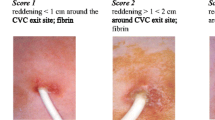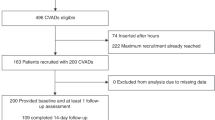Abstract
The aims of this study were to assess the incidence and risk factors of major central venous catheter (CVC)-related complications in a large cohort of children affected by oncological, hematological, or immunological diseases in a 7-year prospective observational study at a single center. Nine hundred fifteen CVCs were inserted in 748 children for a total period of 307,846 CVC-days. Overall, 298 complications were documented with a complication rate of 0.97/1,000 CVC-days: 105 mechanical complications (dislocations 0.30/1,000 CVC-days, ruptures 0.04/1,000 CVC-days), 174 infections (bloodstream infections 0.46/1,000 CVC-days, tunnel infections 0.10/1,000 CVC-days), and 19 thrombosis (0.06/1,000 CVC-days). Significant risk factors were: diagnosis of acute lymphoblastic leukemia (ALL) and age ≤3 years for dislocations; nonmalignant disease for ruptures; ALL for thrombosis; double-lumen and partially implanted CVCs for bloodstream infections; age ≤3 years for tunnel infections. In conclusion, the rate of CVC-related complications in children was lower than that usually reported.
Similar content being viewed by others
References
Adler A, Yaniv I, Steinberg R et al (2006) Infectious complications of implantable ports and Hickman catheters in paediatric haematology-oncology patients. J Hosp Infect 62:358–365. doi:10.1016/j.jhin.2005.08.019
Biffi R, Pozzi S, Agazzi A et al (2004) Use of totally implantable central venous access ports for high dose chemoterapy and blood stem cell transplantation: results of a monocentre series of 376 patients. Ann Oncol 15:296–300. doi:10.1093/annonc/mdh049
Blot SI, Depuydt P, Annemans L et al (2005) Clinical and economic outcomes in critically ill patients with nosocomial catheter-related bloodstream infections. Clin Infect Dis 41:1591–1598. doi:10.1086/497833
Bouza E, Burillo A, Munoz P (2002) Catheter-related infection: diagnosis and intravascular treatment. Clin Microbiol Infect 8:265–274. doi:10.1046/j.1469-0691.2002.00385.x
Castagnola E, Molinari AC, Fratino G, Viscoli C (2003) Conditions associated with infections of indwelling central venous catheters in cancer patients: a summary. Br J Haematol 121:233–239. doi:10.1046/j.1365-2141.2003.04209.x
Cesaro S, Corrò R, Pelosin A et al (2004) A prospective survey on incidence and outcome of Broviac-Hickman catheter-related complications in pediatric patients affected by hematological and oncological diseases. Ann Hematol 83:183–188. doi:10.1007/s00277-003-0796-9
Collignon P, Soni N, Pearson I et al (1988) Sepsis associated with central venous vein catheters in critically ill patients. Intensive Care Med 14:227–231. doi:10.1007/BF00717995
Conter C, Carausu L, Martin E et al (2006) Central venous totally implantable access for high dose chemotherapy in children. Arch Pediatr 13:256–261. doi:10.1016/j.arcped.2005.12.010
De Jonge RC, Polderman KH, Gemke RJ (2005) Central venous catheter use in the pediatric patient: mechanical and infectious complications. Pediatr Crit Care Med 6:329–339. doi:10.1097/01.PCC.0000161074.94315.0A
Debourdeau P, Zammit C, Pavic M et al (2007) Venous thromboembolism associated with long-term use of central venous catheters in cancer patients. Rev Med Interne 28:471–483. doi:10.1016/j.revmed.2007.03.002
Dezfulian C, Lavelle J, Nallamothu BK et al (2003) Rates of infection for single-lumen versus multilumen central venous catheters: a meta-analysis. Crit Care Med 31:2385–2390. doi:10.1097/01.CCM.0000084843.31852.01
Digiovine B, Chenoweth C, Watts C et al (1999) The attributable mortality and costs of primary nosocomial bloodstream infections in the intensive care unit. Am J Respir Crit Care Med 160:976–981
Eggiman P, Pittet D (2002) Overview of catheter-related infections with special emphasis on prevention based on educational programs. Clin Microbiol Infect 8:295–309. doi:10.1046/j.1469-0691.2002.00467.x
Farinasso L, Bertorello N, Garbarini L et al (2007) Risk factors of central venous lines-related thrombosis in children with acute lymphoblastic leukemia during induction therapy: a prospective study. Leukemia 21:552–556. doi:10.1038/sj.leu.2404560
Fratino G, Mazzola C, Buffa P et al (2001) Mechanical complications related to indwelling central venous catheter in pediatric hematology/oncology patients. Pediatr Hematol Oncol 18:317–324. doi:10.1080/088800101300312582
Fratino G, Molinari AC, Mazzola A et al (2002) Prospective study of indwelling central venous catheter-related complications in children with broviac or clampless valved catheters. J Pediatr Hematol Oncol 24:657–661. doi:10.1097/00043426-200211000-00011
Fratino G, Molinari AC, Parodi S et al (2005) Central venous catheter-related complications in children with oncological/hematological diseases: an observational study of 418 devices. Ann Oncol 16:648–654. doi:10.1093/annonc/mdi111
Groeger JS, Lucas AB, Thaler HT et al (1993) Infectious morbidity associated with long-term use of venous access devices in patients with cancer. Ann Intern Med 119:1168–1174
Ingram J, Weitzman S, Greenberg MD et al (1990) Complications of indwelling venous access lines in the pediatric haematological patient: a prospective comparison of external venous catheters and subcutaneous ports. Am J Pediatr Hematol Oncol 13:130–136
Italian Association of Paediatric Hematology and Oncology (Associazione Italiana Ematologia Oncologia Pediatrica) (2005) Recommendations for the management of central venous catheter in Pediatric Onco-Hematology (Raccomandazioni per la gestione del catetere venoso centrale in Onco-Ematologia Pediatrica). Available at http://www.aieop.org
Journeycake JM, Buchaman GR (2003) Thrombotic complications of central venous catheters in children. Curr Opin Hematol 10:369–374. doi:10.1097/00062752-200309000-00008
Journeycake JM, Buchaman GR (2006) Catheter-related deep venous thrombosis and other catheter complications in children with cancer. J Clin Oncol 24:4575–4580. doi:10.1200/JCO.2005.05.5343
Kuter J (2004) Thrombotic complications of central venous catheters in cancer patients. Oncologist 9:207–216. doi:10.1634/theoncologist.9-2-207
Male C, Chait P, Andrew M et al (2003) Central venous line-related thrombosis in children: association with central venous line location and insertion technique. Blood 101:4273–4278. doi:10.1182/blood-2002-09-2731
Male C, Julian JA, Massicotte P et al (2005) Significant association with location of central venous line placement and risk of venous thrombosis in children. Thromb Haemost 94:516–521
Mermel A, Farr B, Sheretz R et al (2001) Guidelines for the management of intravascular catheter-related infections. Clin Infect Dis 32:1249–1272. doi:10.1086/320001
O’Grady NP, Alexander M, Dellinger EP et al (2002) Guidelines for the prevention of intravascular catheter-related infections. Infect Control Hosp Epidemiol 23:759–769. doi:10.1086/502007
Pagano L, Tacconelli E, Laurenti L et al (1997) Bacteremia in patients with haematological malignancies. Analysis of risk factors, etiological agents and prognostic indicators. Haematologica 82:415–419
Pearson ML (1996) Guideline for prevention of intravascular device-related infections. Part 1. Intravascular device-related infections: an overview. The Hospital Infection Control Practises Advisory Committee. Am J Infect Control 24:262–277. doi:10.1016/S0196-6553(96) 90052-8
Pittet D, Tarara D, Wenzel R et al (1994) Nosocomial bloodstream infection in critically ill patients: excess length of stay, extra costs and attributable mortality. JAMA 271:1598–1601. doi:10.1001/jama.271.20.1598
Polderman KH, Girbes ARJ (2002) Central venous catheter use. Part 1: mechanical complications. Intensive Care Med 28:1–17. doi:10.1007/s00134-001-1154-9
Safdar N, Kluger DM, Maki DG (2002) A review of risk for catheter-related bloodstream infection caused by percutaneously inserted, noncuffed central venous catheters. Medicine 81:466–479. doi:10.1097/00005792-200211000-00007
Simon A, Bode U, Beutel K (2006) Diagnosis and treatment of catheter-related infections in pediatric oncology: an update. Clin Microbiol Infect 12:606–620. doi:10.1111/j.1469-0691.2006.01416.x
Templeton A, Schlegel M, Fleisch F et al (2008) Multilumen central venous catheters increase risk for catheter-related bloodstream infection: prospective surveillance study. Infection 36:322–327. doi:10.1007/s15010-008-7314-x
Verso M, Agnelli G (2003) Venous thromboembolism associated with long-term use of central venous catheters in cancer patients. J Clin Oncol 21:3665–3675. doi:10.1200/JCO.2003.08.008
Viscoli C, Castagnola E, Giacchino M et al (1999) Bloodstream infections in children with cancer: a multicentre surveillance study of the Italian Association of Paediatric Haematology and Oncology. Eur J Cancer 35:770–774. doi:10.1016/S0959-8049(99) 00052-0
Acknowledgements
We are grateful to the doctors of the Department of Cardiac Surgery and Cardiology Service, Regina Margherita Children’s Hospital for the surgical collaboration and to our department’s nursing staff for their dedication in taking care of the patients. We are also grateful to Mr. Andrew Martin Garvey for patiently revising our paper.
Conflicts of interest
The authors declare that they have no conflicts of interest.
Author information
Authors and Affiliations
Corresponding author
Rights and permissions
About this article
Cite this article
Pinon, M., Bezzio, S., Tovo, P.A. et al. A prospective 7-year survey on central venous catheter-related complications at a single pediatric hospital. Eur J Pediatr 168, 1505–1512 (2009). https://doi.org/10.1007/s00431-009-0968-2
Received:
Accepted:
Published:
Issue Date:
DOI: https://doi.org/10.1007/s00431-009-0968-2




